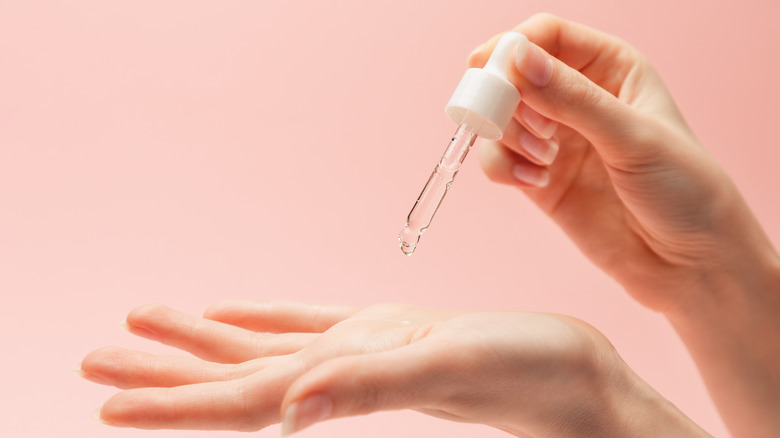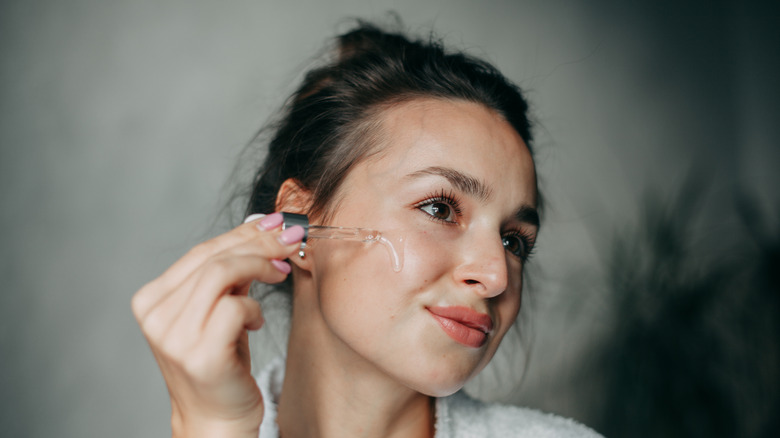Is It Okay To Mix Retinol And Kojic Acid?
Anyone who has experimented with skincare ingredients knows the power that certain combinations can have. Skincare duos like niacinamide and salicylic acid have long been favorites in the skincare world, and with the right blend, you can easily tackle your skin issues during your routine.
With so many possibilities for skincare mixes, it's sometimes challenging to know which ones complement each other and which ones will cancel each other out. Retinol and kojic acid are popular skincare ingredients you'll often find in your favorite skincare combinations, but should you actually be applying them together?
Although many are familiar with retinol and its laundry list of benefits, there are still those that are unaware of what kojic acid can deliver to your skincare routine. While more discreet, kojic acid is an effective antioxidant that can help with hyperpigmentation, according to SkinKraft.
Kojic acid, on its own, is a powerful ingredient, but when mixed with other skincare ingredients, it can be an even more powerful product. However, if you're already a fan of retinol, it's crucial to know if these two skincare ingredients get along. When mixing ingredients, you always want to ensure your skincare will help your skin instead of damaging it further.
Should you combine retinol and kojic acid?
Thankfully, for fans of both ingredients, this pair is not only safe to use together, but it's recommended for quickly repairing hyperpigmentation. Although kojic acid is potent, it's also a gentle formula that can easily be mixed with other similar ingredients, like retinol. Alison Adams-Woodford, senior manager of research and development at PCA Skin, tells AEdit, "It is also good to pair kojic acid with other ingredients that address skin discoloration through different mechanisms to disrupt the biological pathway of melanin production from multiple angles." Since retinol also works to fade signs of hyperpigmentation, kojic acid should have no problem working with retinol to tackle the discoloration quicker.
Beautiful with Brains reiterates this combination by recommending using them in the same routine at night. Kojic acid helps inhibit tyrosinase, the enzyme behind melanin production. Retinols, on the other hand, reach deep into the skin to help regenerate collagen and cell production. Using both of these ingredients will target your hyperpigmentation in various directions to ensure it fades away quickly. However, whenever using an acid or retinol, you want to start slowly, as it can irritate the most sensitive skin types.
How to apply retinol and kojic acid
Using retinol and kojic acid is simple and easy. However, there are a few things to keep in mind before applying them. Since both help fade hyperpigmentation and work by inhibiting melanin, you want to ensure you have significant protection against the sun. Dr. Parisha Acharya, an aesthetic doctor at Waterhouse Young, tells Refinery29, "SPF should be an absolute no-brainer in our skincare regime. However, it is especially important with kojic acid, as there is a risk of sunburn and skin sensitivity. You should always apply a high-quality SPF when using a product containing this ingredient." Whether you use this combination at night or during the day, ensure to have enough sun protection for the entire time you use both ingredients.
When starting kojic acid or retinol, you want to start with small doses before making it continuous. Dermatologist Dr. Parul Khot explains to Be Beautiful, "The safety concept is 1-4 % in concentration, but 1-2 % is the starter limit for first-time users. This brightening powerhouse is available as a solo product or in combination with vitamin C, retinol, glycolic acid, arbutin, etc. The frequency of use that I would recommend is twice a day, followed by sunscreen, mandatorily. " Any time you integrate such potent ingredients into your skincare routine, ensure your skin doesn't get irritated before continuing usage. Since both skincare ingredients can cause irritation, pay attention to how your skin reacts after the initial application.


